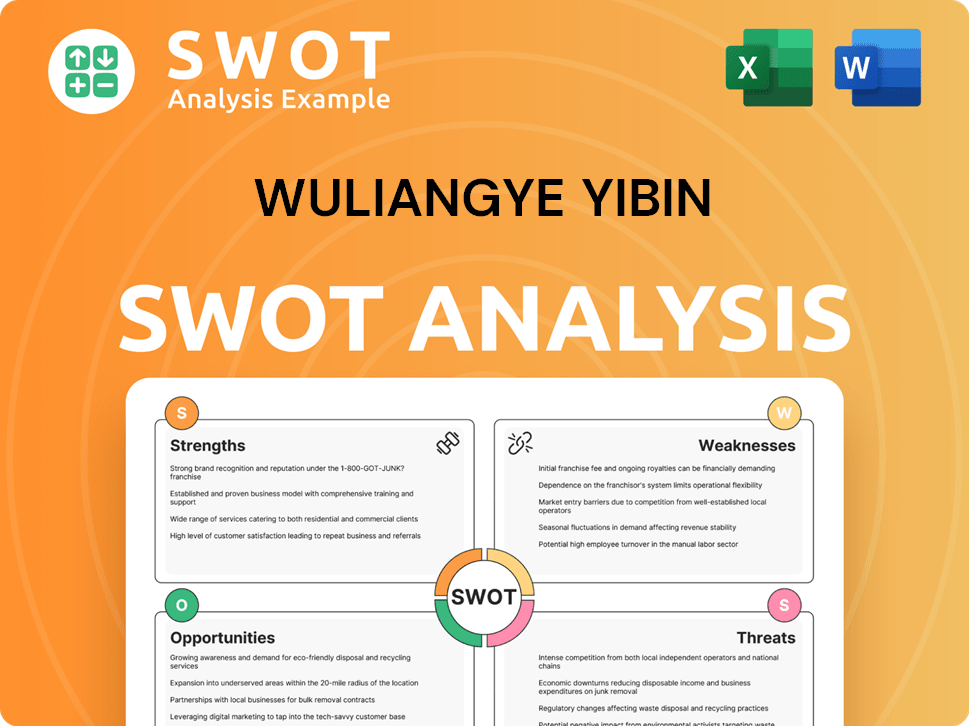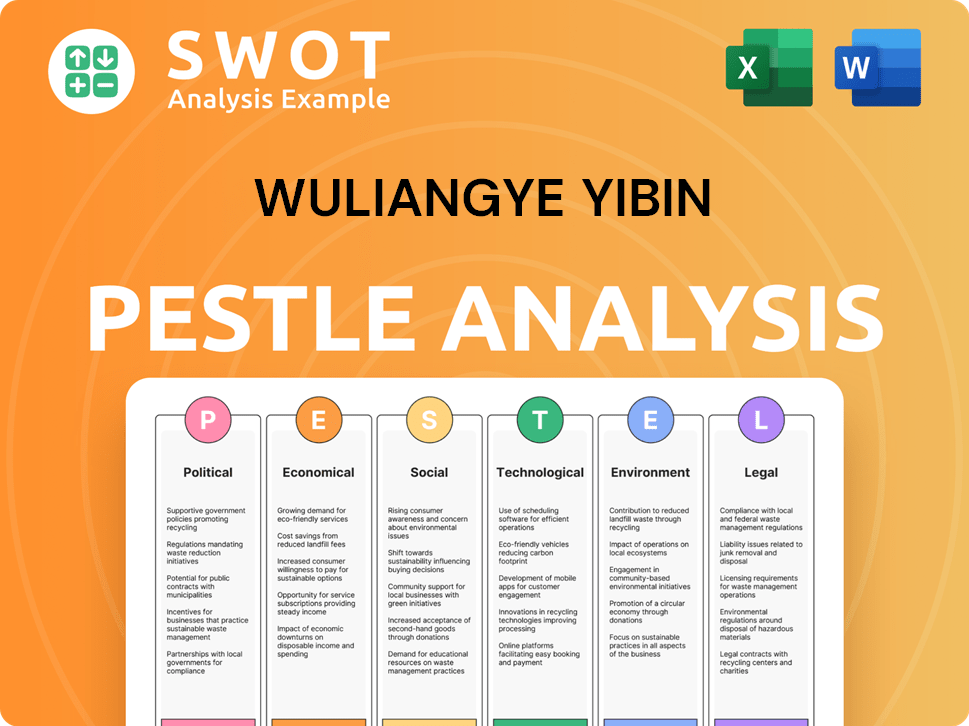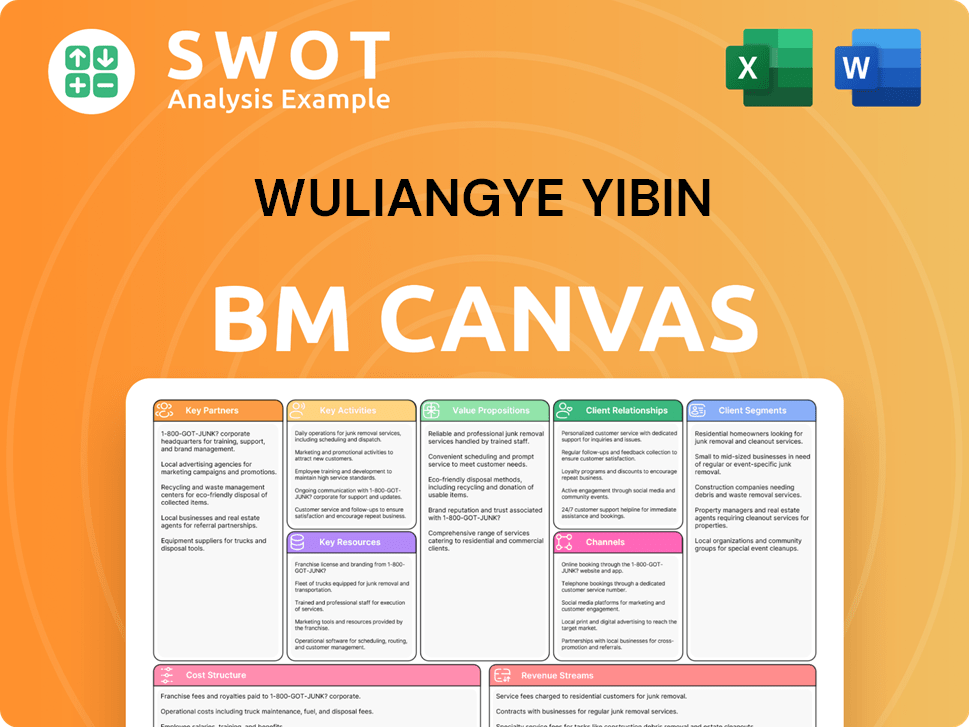Wuliangye Yibin Bundle
Who Truly Owns Wuliangye Yibin?
Unraveling the Wuliangye Yibin SWOT Analysis reveals more than just market strategies; it highlights the core of its operations: its ownership. Understanding who owns Wuliangye is critical to grasping its long-term vision and financial health within the competitive Chinese liquor market. From its origins to its current status as a global baijiu brand, the ownership structure of this company has evolved significantly.

The evolution of Wuliangye Yibin's ownership, from its roots as a state-owned enterprise to its current publicly traded status, offers valuable insights. Knowing who the major investors in Wuliangye are and the details of Wuliangye Yibin's board of directors can provide a deeper understanding of its strategic direction. This exploration will delve into the Wuliangye Yibin ownership history, providing a comprehensive view of the company's corporate structure and its impact on its market performance.
Who Founded Wuliangye Yibin?
The story of Wuliangye Yibin's ownership begins in 1950 with the merging of eight distilleries in Yibin by the newly established People's Republic of China. This merger resulted in a single state-owned entity, which was officially named Wuliangye in 1959.
Unlike companies with individual founders, Wuliangye's initial ownership structure was entirely state-owned. The company's evolution reflects China's economic shifts, moving from state control to a joint-stock model.
The formal establishment of Wuliangye Yibin Co., Ltd. occurred on April 21, 1998. This was part of a restructuring process that involved transforming the Wuliangye Distillery into Wuliangye Group and Wuliangye Yibin Co. Ltd. This restructuring was a key step in preparing the company for its public listing.
Wuliangye's early ownership was fundamentally state-owned, reflecting the economic policies of the time.
The transition to a joint-stock limited liability company in 1998 was a significant change.
The restructuring in 1998 was a crucial step toward the company's public listing.
The allocation of shares before the IPO primarily involved state-affiliated entities.
The company's origins as a state-owned enterprise have significantly shaped its ownership history.
Wuliangye does not have traditional individual founders in the same way as privately established companies.
Understanding the ownership structure of Wuliangye Yibin is essential for anyone interested in this major Chinese liquor brand. Key aspects include its state-owned origins, the transition to a joint-stock company, and the subsequent public listing. The primary owner of Wuliangye Yibin is Wuliangye Group. Information on the specific shareholders and the percentage of shares they hold can be found in the company's financial reports and investor relations materials. In 2024, Wuliangye Yibin's revenue reached approximately 80.7 billion yuan, demonstrating its strong market position. The company's ownership structure has evolved, but it remains largely influenced by state-affiliated entities. The company's market capitalization is a key indicator of its value and is influenced by its ownership structure and performance. As of late 2024, the company's market capitalization was around $60 billion USD.
- The initial ownership of Wuliangye was entirely state-controlled.
- The 1998 restructuring paved the way for its public listing.
- The company's ownership structure is primarily influenced by state-affiliated entities.
- Wuliangye Group is the primary owner.
Wuliangye Yibin SWOT Analysis
- Complete SWOT Breakdown
- Fully Customizable
- Editable in Excel & Word
- Professional Formatting
- Investor-Ready Format

How Has Wuliangye Yibin’s Ownership Changed Over Time?
The evolution of the Wuliangye Yibin ownership structure began with its public listing on the Shenzhen Stock Exchange on April 27, 1998. This pivotal event transformed the Wuliangye company from a state-owned entity into a publicly traded one, opening it up to a diverse range of investors, including institutional and individual shareholders. This transition marked a significant shift in its operational and financial landscape, allowing for greater market participation and potential for growth.
The shift from a solely state-owned enterprise to a publicly traded company with a mix of shareholders has been a key factor in its development. The Wuliangye owner structure has been influenced by the Chinese government's strategic economic policies, which aim to balance state control with market-driven operations. This structure has allowed the company to leverage both government support and market dynamics to achieve its goals.
| Event | Date | Impact on Ownership |
|---|---|---|
| Initial Public Offering (IPO) | April 27, 1998 | Transitioned from state-owned to publicly traded, introducing institutional and individual shareholders. |
| Ongoing Shareholder Dynamics | 2023-2025 | State-owned entities remain dominant, with Yibin Development Holding Group Co., Ltd. as the controlling shareholder. Institutional investors hold significant shares. |
| Regulatory Changes | Ongoing | Changes in regulations can impact shareholding structures and ownership percentages. |
As of December 30, 2024, Yibin Development Holding Group Co., Ltd. holds approximately 54.92% of the shares, solidifying its position as the controlling shareholder. Sichuan Yibin Wuliangye Group Co., Ltd., a wholly-owned subsidiary of Yibin Development Holding Group Co., Ltd., holds approximately 20.49% as of November 6, 2024. This structure illustrates the significant influence of state-owned entities. Other major shareholders include China Securities Finance Corporation Ltd. with approximately 2.38%, E Fund Management Co., Ltd. with approximately 1.27%, China Merchants Fund Management Co., Ltd. with about 1.24%, and Central Huijin Asset Management Co., Ltd. with approximately 1.01% as of December 30, 2024. The presence of institutional investors, such as mutual funds and asset management firms, also contributes to the diverse shareholder base. For more details, you can explore the Brief History of Wuliangye Yibin.
Understanding the Wuliangye Yibin ownership structure is crucial for investors and stakeholders.
- The controlling shareholder is state-owned, ensuring government influence.
- Institutional investors hold significant shares, contributing to market dynamics.
- The ownership structure reflects a blend of state control and market participation.
- Regularly check financial reports for the latest ownership data.
Wuliangye Yibin PESTLE Analysis
- Covers All 6 PESTLE Categories
- No Research Needed – Save Hours of Work
- Built by Experts, Trusted by Consultants
- Instant Download, Ready to Use
- 100% Editable, Fully Customizable

Who Sits on Wuliangye Yibin’s Board?
The Board of Directors of Wuliangye Yibin Co., Ltd. is pivotal in the company's governance. As of April 26, 2025, Zeng Congqin holds the position of Chairman of the Board. The board's composition reflects the interests of the dominant state shareholder, typical in state-controlled enterprises. Information on specific board members and their affiliations for 2024-2025 is not readily available in public summaries.
The structure of the board is influenced by the significant ownership of state-owned entities. The company's governance is generally stable, given the strong state ownership, making it less susceptible to external activist investor pressures. Understanding the board's composition and the influence of the major shareholders is key to grasping the company's operational dynamics.
| Board Member | Position | Affiliation |
|---|---|---|
| Zeng Congqin | Chairman of the Board | N/A |
| Not Publicly Available | Board Members | Representing Major Shareholders, Founders, or Independent Seats |
| Not Publicly Available | Board Members | Representing Major Shareholders, Founders, or Independent Seats |
The voting structure at Wuliangye Yibin typically follows a one-share-one-vote principle, common in publicly traded companies. Shareholders can vote online via the Shenzhen Stock Exchange's trading system or its website. However, the substantial ownership by state-owned entities, such as Yibin Development Holding Group Co., Ltd., grants them considerable control and voting power. The influence of the state-owned parent group extends across its various holdings. For more insights, consider exploring the Competitors Landscape of Wuliangye Yibin.
Wuliangye Yibin's ownership structure is significantly influenced by state-owned entities. The voting power is largely determined by the shareholding of these major shareholders. This structure provides stability but also limits the influence of external investors.
- State-owned entities hold significant voting power.
- One-share-one-vote principle generally applies.
- Governance is stable due to strong state ownership.
- Limited information on recent proxy battles.
Wuliangye Yibin Business Model Canvas
- Complete 9-Block Business Model Canvas
- Effortlessly Communicate Your Business Strategy
- Investor-Ready BMC Format
- 100% Editable and Customizable
- Clear and Structured Layout

What Recent Changes Have Shaped Wuliangye Yibin’s Ownership Landscape?
In the past few years (2022-2025), the ownership structure of Wuliangye Yibin has remained largely stable. The state-owned Yibin Development Holding Group Co., Ltd., and its subsidiary Sichuan Yibin Wuliangye Group Co., Ltd., continue to hold significant majority stakes. As of late 2024 and early 2025, Yibin Development Holding Group Co., Ltd. held approximately 54.92% of the shares, and Sichuan Yibin Wuliangye Group Co., Ltd. held around 20.49%. This indicates a consistent strong state influence over the company's strategic direction.
While there haven't been major share buybacks or secondary offerings that have significantly impacted the ownership structure, Wuliangye has demonstrated a commitment to shareholder returns. In Q4 2024, the company announced a dividend of CNY 4.67 per share, a 23% increase from 2023. This marks its fourth consecutive dividend increase, with an average annual compound growth rate of 34.7% over the past four years. This is a key factor for investors looking at the Wuliangye owner profile.
Wuliangye has also been diversifying beyond its core baijiu business. For example, in 2018, it partnered with a Yibin government investment firm to acquire a 51% stake in Kaiyi Auto. More recently, in November 2023, it signed a memorandum of understanding with the Italian group Campari to collaborate on new products. The company's consistent double-digit revenue growth, with a 12% rise in 2024, and improved net profit margins (36.4% in 2024, up from 26.5% in 2020), underscore its strong market position. For more details on the company's financial performance, you can read Revenue Streams & Business Model of Wuliangye Yibin.
The ownership structure of Wuliangye has remained stable, with state-owned entities maintaining control. This stability is a key characteristic for investors.
Wuliangye has consistently increased dividends, demonstrating a commitment to shareholder value. The dividend increases reflect the company's financial health.
Wuliangye is expanding beyond its core business through partnerships and acquisitions. These moves show the company's strategic vision.
The company's strong revenue growth and improved margins highlight its success in the Chinese liquor market. These are key indicators of the company's strength.
Wuliangye Yibin Porter's Five Forces Analysis
- Covers All 5 Competitive Forces in Detail
- Structured for Consultants, Students, and Founders
- 100% Editable in Microsoft Word & Excel
- Instant Digital Download – Use Immediately
- Compatible with Mac & PC – Fully Unlocked

Related Blogs
- What are Mission Vision & Core Values of Wuliangye Yibin Company?
- What is Competitive Landscape of Wuliangye Yibin Company?
- What is Growth Strategy and Future Prospects of Wuliangye Yibin Company?
- How Does Wuliangye Yibin Company Work?
- What is Sales and Marketing Strategy of Wuliangye Yibin Company?
- What is Brief History of Wuliangye Yibin Company?
- What is Customer Demographics and Target Market of Wuliangye Yibin Company?
Disclaimer
All information, articles, and product details provided on this website are for general informational and educational purposes only. We do not claim any ownership over, nor do we intend to infringe upon, any trademarks, copyrights, logos, brand names, or other intellectual property mentioned or depicted on this site. Such intellectual property remains the property of its respective owners, and any references here are made solely for identification or informational purposes, without implying any affiliation, endorsement, or partnership.
We make no representations or warranties, express or implied, regarding the accuracy, completeness, or suitability of any content or products presented. Nothing on this website should be construed as legal, tax, investment, financial, medical, or other professional advice. In addition, no part of this site—including articles or product references—constitutes a solicitation, recommendation, endorsement, advertisement, or offer to buy or sell any securities, franchises, or other financial instruments, particularly in jurisdictions where such activity would be unlawful.
All content is of a general nature and may not address the specific circumstances of any individual or entity. It is not a substitute for professional advice or services. Any actions you take based on the information provided here are strictly at your own risk. You accept full responsibility for any decisions or outcomes arising from your use of this website and agree to release us from any liability in connection with your use of, or reliance upon, the content or products found herein.